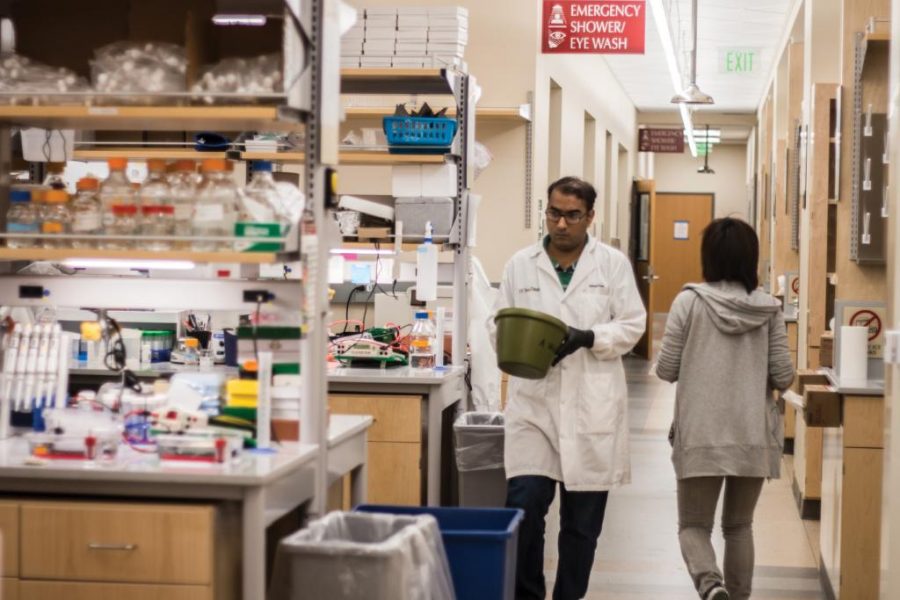October is National Breast Cancer Awareness Month, an event promoted by both national and international breast cancer charities, like the American Cancer Society, to help raise awareness and money for breast cancer research toward finding a cure. According to the National Cancer Institute, approximately 12.4 percent of women will be diagnosed with breast cancer in their lifetime. Since the inception of Breast Cancer Awareness Month, researchers at the University of Utah have been at the forefront of research into the disease.
Finding the Cause
In 1990, the first evidence that genes are responsible for inherited forms of breast cancer was seen at the University of California, Berkeley. Four years later, a partnership of three groups, including researchers at the U, published data indicating they had isolated a gene involved called BRCA1.
When cells divide — which is how new cells are produced — each gene inside the DNA of the original cell must be copied so the new one has the genetic information necessary to function. Accuracy in this copying process is important in ensuring that the new cell operates correctly, because DNA dictates how everything is made and works. This process includes giving directions to eliminate errors. As a result, there are only about three errors per cell.
Cancer happens when enough errors build up that a cell loses the ability to regulate the frequency with which it divides. As the out-of-control cell splits repeatedly and makes new cells that also cannot regulate the rate of cell division and divide frequently, tumors form.
Normally functioning, BRCA1 provides the instructions for cells to build proteins that help them cope with damaged DNA, so they never reach the stage of uncontrollable division. If a copying error, also called a mutation, occurs in BRCA1, breast cancer is far more likely.
Approximately one in 1,000 people inherit an already damaged copy of BRCA1 from either their mother or father. Famously, Angelina Jolie chose to undergo surgeries to remove her breasts and ovaries after she and her doctors discovered she had inherited a malfunctioning copy of the gene.
The U was also involved in the discovery of a second gene playing a role in breast cancer — BRCA2 — at about the same time.
Working Toward a Cure
The work of breast cancer researchers at the U hasn’t stopped since then.
Just this year, Huntsman Cancer Institute researcher and oncological sciences professor Alana Welm published major findings about the disease and how to treat it.
There comes a point in the growth of a tumor when cells can break off and move to different areas of the body, often via the bloodstream, and begin to form new tumors. This process, called metastasis, is the most deadly part of cancer, according to Welm. She says the most common places for cancer to metastasize to are the bones, lungs, liver or brain.
According to the American Cancer Society, cells must undergo significant changes in order to survive the move from the original tumor. Sometimes the cells can become resistant to drugs because of those changes. Welm’s lab focuses on metastasis and is trying to understand how drug resistance happens. They hope that if they can understand the process, they’ll be able to find ways to interrupt it, leaving the cancer cells vulnerable to drugs that can kill them.
Welm’s recent work has looked at bone metastasis in particular. She said it is the most common location for breast cancer to spread. When it does, it results in bone degradation, which causes severe pain and fractures.
“The bone literally gets holes in it,” Welm said.
Her lab found a protein which regulates metastasis to the bones. They also found a chemical that can block the process.
Working with a lab in Singapore, her lab held a phase 1 clinical trial, which is for experimental drugs. These types of studies are typically done on healthy patients in order to test safety, but the drug still had good results because bone degradation naturally occurs as a result of aging. A little less than two-thirds of the patients experienced less bone destruction, and about the same amount experienced bone repair.
Welm said within the next month a very similar drug will enter phase 2 clinical trials in Utah to see if bones can be protected from damage. Phase 2 clinical trials are usually done to test the effectiveness of a drug in patients with the specific disease — in this case metastatic breast cancer.
Welm’s group also recently won a collaborative grant, along with her husband’s team and labs from other universities, from the National Cancer Institute to be one of four institutions in the nation working under what’s called a PDX model. Under this model, breast cancer is studied by growing tumors derived from patients’ cells in mice and analyzing what happens as the tissue grows, then basing treatment off of those results. Welm said this method is especially useful when testing new drugs because it can pinpoint patients who would be helped the most by that specific treatment.
It’s not just her group studying breast cancer at the U. Welm said there are at least 10 other research groups studying every stage of breast cancer including how it starts, its nature once it has begun, how it spreads and possible therapies. She said the teams have “great expertise at every stage of cancer,” resulting in a diverse spectrum of research working toward prevention, treatment and a cure for the disease.
e.vandersteen@dailyutahchronicle.com
@EliseAbril



